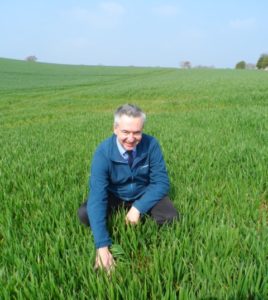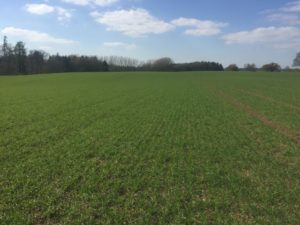
Arable crops are coming under increasing drought pressure, with many also suffering from micronutrient deficiencies, so farmers should consider innovative foliar treatments this spring.
According to the Environment Agency, England received just 85% of the long-term average rainfall between January and March, despite March being wetter than normal. April has also been dry, leaving many soils – particularly in the East – with significant moisture deficits.
“Most crops got off to an early start with the warm February, and a lot of farmers applied nitrogen early so the crops grew on ahead of normal,” says Bryn Thomas, agronomist at Spunhill. “But since then everything has slowed down, with lengthening days and warmer soils required for growth stage progression.”
Many crops have used up the early-applied nitrogen, and the dry weather has also limited nutrient availability, stalling crop growth, he adds. To help alleviate the drought stress, farmers should consider adding a proven biostimulant to their T1 fungicide application.
“We’ve been doing split field trials looking at yield and crop health with biostimulants and the science backs them up. As we lose more pesticide active ingredients we’re going to have to do more to look after plant health and last year we found biostimulants like Proplex helped alleviate drought stress.”
Doug Chaplin, operations manager at Olmix-Micromix, recommends using either C-Weed AAA or Proplex to stimulate root and plant development. “C-Weed AAA contains a highly concentrated extract of Ascophyllum nodosum, which has unique marine-based compounds that alleviate stress and stimulate growth in land plants. It is also high in natural plant amino acids which are essential for cell growth.”
 Proplex is a more complex formulation which also includes micronutrients and sulphur and has proven to keep crops growing even in extreme heat and drought. “It’s shown to promote root hairs not just root length – and that is the active part of the root that takes up water and nutrients,” explains Mr Chaplin.
Proplex is a more complex formulation which also includes micronutrients and sulphur and has proven to keep crops growing even in extreme heat and drought. “It’s shown to promote root hairs not just root length – and that is the active part of the root that takes up water and nutrients,” explains Mr Chaplin.
“Under stress conditions plants tend to start shutting down, but these biostimulants keep them growing for longer, ultimately boosting yield and quality.”
Mr Thomas has been carrying out a lot of tissue analysis on farms, which has thrown up nutrient deficiencies this spring, particularly in magnesium, zinc and boron, which are essential for growth and fertility.
“We’re looking at using foliar nutrients including manganese, magnesium, zinc and copper alongside the biostimulants. The advantage of foliar application is that you get rapid uptake and target nutrients straight into the leaf in a bio-available formulation.”
Magnesium deficiency is showing up in a lot of recent analysis, and it will be important to address this at T1 in wheat, as it is key for chlorophyll production and photosynthesis, warns Mr Thomas.
“Boron – often considered important for oilseed rape and sugar beet – I think is a hidden hunger, and in cereals is vital for fertility and ear formation. It’s important to get the balance right as in high levels it is phyto-toxic. That’s where tissue testing proves its worth – rather than blanket application you know that you’re doing the right thing.”
Although the dry weather has eased some disease pressure this spring, it’s important not to cut back on fungicide use, as conditions can rapidly change and the fungicidal activity now relies much more on prevention than cure, says Mr Thomas. “Adding a biostimulant can help to elicit the plant’s own defence mechanism and work in conjunction with fungicide applications.”
Farmers can use pretty low rates of 0.5 litres of Proplex or C-Weed AAA per hectare, explains Mr Chaplin. “So it’s really not expensive. Micromix was one of the first to combine the power of different biostimulants and amino acids, and both products have been widely tested in different tank mixes. We know they work extremely well, boosting plant growth and resilience against disease, should the weather turn warm and wet later in the year.”
- For more information visit micromix.com.




